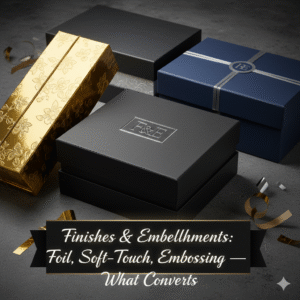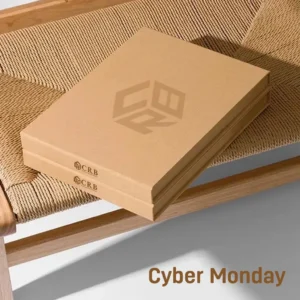Ipsos Market Research reports that more than 72% of consumers state that purchasing decisions are based directly on packaging design; this is especially true for luxury products.
Packaging is more than just protection; it is an indicator of positioning.
When brands must select between rigid boxes and folding cartons, they are selecting content and, ultimately, how consumers will feel about their product; both serve a purpose, but their consequences on cost, protection, and perception can be very different.
This guide breaks down the real differences between rigid packaging boxes and folding carton packaging, helping you decide which one fits your brand’s goals and budget.
Rigid Boxes and Folding Cartons
Rigid boxes, also described as rigid set-up boxes, are made from chipboard or greyboard, ranging in thickness from 1.5 mm to 3 mm. Rigid boxes are covered in decorated paper or fabric and are designed to be durable.
Rigid boxes convey the luxury of never losing shape, being built to resist wear, and being noteworthy and present in hand.
Luxury brands that sell perfume, tech accessories, and jewelry use the performative experience of rigid box packaging to affordably cue premium value through tactile engagement and structure.
Folding cartons are constructed for efficiency.
In contrast to rigid boxes, folding cartons are made from thinner paperboard that can be flattened for shipping. Folding cartons are see-in widespread used for consumer goods, such as cosmetics, electronics, and retail.
Their lightweight structure helps lower costs, take up less space for storage, and weigh less for freight, making folding cartons the most effective option for mass-market and e-commerce brands that desire scalability.
Rigid vs Folding Carton Packaging: The Key Differences

Both packaging styles have distinct strengths. The right choice depends on whether your brand prioritizes luxury perception, cost control, or shipping efficiency.
- Material & Structure
- Rigid Boxes: Constructed from heavy chipboard (1.5-3 mm thick). They are not collapsible and will always keep their shape.
- Folding Cartons: Constructed from thin paperboard (250-600 gsm), which can neatly fold flat for easy shipment- ideal for shipping.
- Strength & Protection
Rigid boxes are much more able to sustain compression, moisture, and impact, ideal for delicate or higher-end products.
Folding cartons protect lighter or mid-tier products, but are not as suitable for compression and moisture protection
- Cost & Production
- Rigid Box Cost: Tends to cost 3-5x more than folding cartons due to the materials and due to manual assembly practices.
- Folding Carton Cost: Less expensive production costs and transportation costs due to automated folding lines and compacted shipment.
Brands sometimes offset the price of a rigid box by using a premium or luxury perception, and perceived unboxing product value usually compensates price increase.
- Storage & Logistics
Foldable rigid boxes add the best of both worlds, fold into storage compact and conditioned storage space yet still premium in feel. They will ship flat like folding cartons, yet once assembled, they return to being rigid.
- Branding & Presentation
Rigid packaging boxes offer the most potential for customization, foil stamping, embossing, magnetic closures, and/or textured wraps.
Folding cartons offer efficient print and graphic processing. However, they do not have the tactile “luxury feel” provided naturally through a rigid box.
Cost Comparison: What You Really Pay For
| Feature | Rigid Boxes | Folding Cartons |
| Material Cost | High (thick chipboard) | Low (thin paperboard) |
| Setup & Labor | Manual assembly increases cost | Automated folding reduces labor |
| Storage | Bulky, requires space | Compact, ships flat |
| Perceived Value | Very high | Moderate |
| Ideal For | Luxury, gift, premium retail | Everyday consumer products |
While rigid box price per unit is higher, its return on perception, the visual and tactile appeal, is unmatched. Studies show that premium packaging increases repeat purchases by 40% in luxury segments.
Rigid Box Styles That Eclipse Folding Cartons
| Rigid Box Style | Description | Best Used For / Brand Type |
| Two-Piece Rigid Set-Up Boxes | A timeless classic with a tight-fitting lid and base. The friction-fit design creates a slow, refined opening experience that conveys exclusivity and craftsmanship. | Luxury jewelry, watches, high-end cosmetics, and premium tech products. |
| Magnetic Closure Boxes | Sleek, modern, and functional, these boxes feature hidden magnetic locks that close seamlessly. The clean edges and satisfying “click” enhance the unboxing moment. | Electronics, corporate gifts, premium product launches, and influencer packaging. |
| Foldable Rigid Boxes | A hybrid innovation that merges the elegance of rigid packaging with the practicality of folding cartons. Ships flat to reduce freight and storage costs. | Global e-commerce brands and sustainable product lines seeking compact luxury. |
| Kraft Rigid Boxes | Made from recycled kraft paperboard, these boxes project authenticity and eco-conscious values while maintaining a refined aesthetic. | Sustainable luxury brands, organic beauty, and eco-friendly packaging collections. |
Brand Impact: The Power of Perceived Value
Luxury branding is based on one principle — perception = value.
When customers encounter a rigid packaging box, they view it as constructed and authoritative.
In high-ticket items, the function of packaging extends beyond protecting items; instead, it becomes a marketing tool.
A well-engineered, rigid set-up box lends credibility and pre-sells the product before it has even been seen. While folding cartons offer scalable options, they assist startups and mid-level brands in driving down costs without losing creative design.
Conclusion: Beyond Protection — A Promise of Prestige

In the evolving world of brand packaging, rigid boxes and folding cartons serve distinct roles. Folding cartons are efficient; rigid boxes are emotional.
If your goal is to build brand equity and customer trust, rigid packaging boxes are your strongest investment. They don’t just hold products, they hold attention, loyalty, and the promise of something worth remembering.
The next time you weigh rigid vs folding carton packaging, ask yourself one question:
Are you protecting a product, or presenting a brand experience? Contact us today to get the prices in the market.
FAQs
1. What distinguishes rigid boxes from folding cartons?
Rigid boxes are thicker and cannot be collapsed, made for luxury packaging, and folding cartons are thinner, more lightweight, and for retail packaging that is generally sold in higher volume.
2. Are rigid boxes a good investment for the extra cost?
Yes, while a rigid box is more costly than other packaging options, it generates a substantial brand perception value, product protection, and a better overall unboxing experience.
3. What are foldable rigid boxes?
Foldable rigid boxes allow you to incorporate the sturdiness of rigid packaging while retaining the ease of folding carton to save space for e-commerce and global shipping.
4. What materials do rigid set-up boxes use?
Often chipboard, greyboard, or kraft paperboard that is wrapped in decorative or printed paper sheets.
5. Where can I find a supplier or manufacturer of rigid boxes?
Manufacturers for rigid boxes exist and should have a specialty in custom premium rigid boxes for bulk and use rigid set-up boxes wholesale, or design rigid boxes for you for consistency and affordable pricing.





